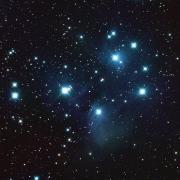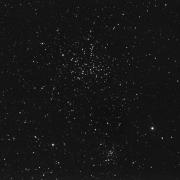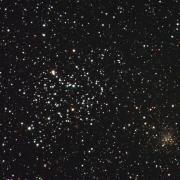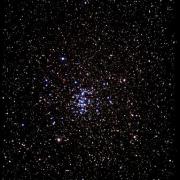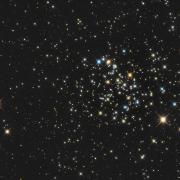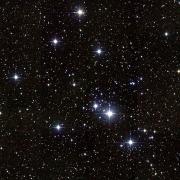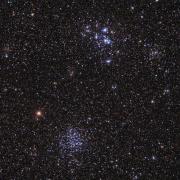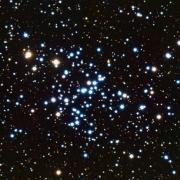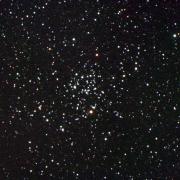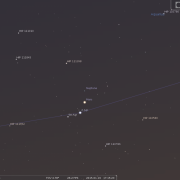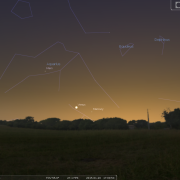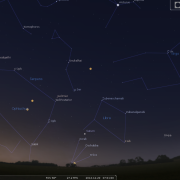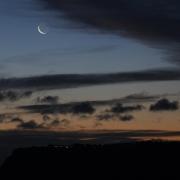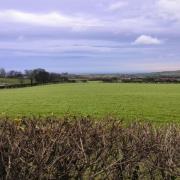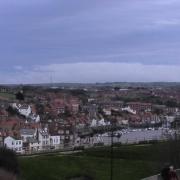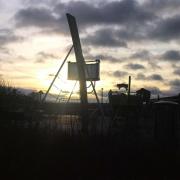A second Happy New Year to all WDAS Members.
Using a new Website engine from this month, the January 2015 newsletter arrived well for most Members but had formatting issues for a few, so I promised we'd investigate and re-send it. Well, we've investigated and fixed what we can, and here's the re-send.
For everybody who received it fine on the first send, it's still worth another look... there's a new article on Comet Lovejoy which wasn't in the original January Newsletter. Mark, Keith and Andi viewed the comet last night (Monday 13th January) in a bitter wind through haze at the top of Skelder Bank and we can confirm... it's definitely there! Read the article below for all the details!
If you do find any formatting problems with second copy of the newsletter, please do reply and let us know what's wrong so we can try and fix it. Otherwise... enjoy the late edition, and see you all next month!
Society News
 A while after the Christmas Meal at the Hare & Hounds, Mark received found this write-up by a curmudgeonly old Scrooge, lying below his letter-box...
A while after the Christmas Meal at the Hare & Hounds, Mark received found this write-up by a curmudgeonly old Scrooge, lying below his letter-box...
Baa.. Humbug, all this festive cheer and good will to all men; fiddle sticks I say!
Indeed just the other week I had the great displeasure of attending a most disagreeable gathering at the Hare and Hounds public house. Far from the anticipated disaster I was expecting, not only did the ‘pick up’ arrangements go to plan, the whole operation ran like clockwork, with everyone being ferried up to the establishment on time and without mishap. Then, the exchange of Christmas cards, which I was led to believe would be an embarrassing fiasco, put our good Queen’s mailing service to shame. Everyone was in annoyingly good spirits, which as the wine bottles emptied became ever more unbearable. Instead of the substandard, small and putrid seasonal offerings expected, the food was grievously satisfying, copious and delicious with the establishments hosts sickeningly cheerful.. Baa humbug. At least the wretched waifs and strays of the village would not be dining out on any leftovers.... there weren’t any.... hahaha... cough, cough.
A surprise presentation to one of the society members... err Mark somebody or other, the name escapes me... seemed to create tremendous and uncalled for hilarity. Contained within a small sparkly box was a monocle... yes a monocle would you believe, I don’t know the poor fellow spent most of the evening contorting his face trying to keep little blighter in... difficult beasties you know, I have one, takes years of practise. I do believe the fellow was genuinely touched by the gesture though.
Well I have very little else to say on the evenings affairs, and no it wasn’t because of the drink.... devil’s liqueur I say, water and god’s own turnip would be my choice, suffice to say most of the others disagreed in that sentiment. But I am not one to gossip. Eventually the merriment and good tidings concluded... and not before time I say, such cosy surroundings are far too conducive I deem for serious society matters. Why, I’ll wager that if matters continue like this... well, I can foresee a similar intolerance occurring this time next year... or it is this year? .. I don’t know, my water has been spiked by the devil. Baa Humbug!
Phase Transition

Party Photos
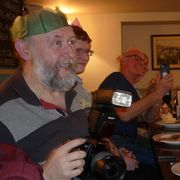 |
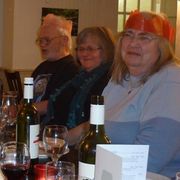 |
 |
 |
 Thanks to all Members for supporting the Society over the past year. Along with donations from visitors at star parties, your help and support has meant that hundreds of holiday-makers as well as cubs and scout groups, schools and residents of Whitby and surrounding villages have been able to share our delight in the night sky.
Thanks to all Members for supporting the Society over the past year. Along with donations from visitors at star parties, your help and support has meant that hundreds of holiday-makers as well as cubs and scout groups, schools and residents of Whitby and surrounding villages have been able to share our delight in the night sky.
It's been a fabulous year, which has seen the launch of a new-look newsletter, lots of improvements to the Society website, and increasing Members joining the WDAS monthly meetings. That's not to mention our participation in Whitby Festival, Whitby Regatta, Science Week, joining in Leeds Astromeet and other Societies' events, and - hey - a great Christmas Party together.
Now that we're into 2015, WDAS Subs for the new year are due, giving you the thrill of supporting WDAS for a whole new year of excitement! Thanks indeed to all the Members who have already paid.
Subs will be held at current levels, which for the coming year are:
- £12 for Adults
- £5 for Under-16s
+ copies of Paul Money's comprehensive 'Night Scenes' Almanac at the special price of £4 for Members
You can bring subs along to the WDAS monthly meetings in January, or February at the very latest.
If you cannot make the meetings, cheques are welcome. Please make them payable to: Whitby & District Astronomical Society, and address them to Mark Dawson - 33 laburnum Grove, Whitby. YO21 1HZ.
Thanks for your support!
In-Focus
One of the many delights of observing the Winter night sky is noting the diverse range of Open Clusters visible to the naked eye, binoculars and telescope alike. But what is an Open Cluster?
Open Clusters: clusters of young stars (usually no older than 500 million yrs) of roughly the same age, born from the same large cloud of gas (like the Orion Nebula) and are now only just starting to slowly move away from their stellar nursery (due to the pull of other stars in the spiral arms of our galaxy). Open clusters sometimes, called Galactic clusters, range in size from a few tens of stars up to a few thousand stars. Related to open clusters are Associations, very loose groupings of stars of common origin.
Let us now take a tour of the more prominent open clusters visible in the winter sky starting with M45, the Pleiades or "Seven sisters", found to the upper right of Aldeberan, in Taurus. This distinctive cluster is one of the jewels of the heavens, especially when viewed at low power, i.e. with binoculars. In a scope up to 50 stars are visible, though not in the same field. The cluster actually contains over 350 members lying some 400 light-years away. It is estimated that the cluster is around 100 million years old. A good example of a loose cluster is the Hyades, the “v” shape of stars dominated by Aldeberan in Taurus. This is an illusion as Aldeberan is half the distance of the Hyades members.
Next find the constellation of Auriga high above Taurus and marked by the prominent star Capella. Using binoculars sweep the area between Theta and Iota Aurigae you will notice 3 faint hazy patches, these are the open clusters M36, M37 and M38.
M38 (top) and M36 are seen in the same binocular field, M37 is situated to the lower left. For small scopes, M36 is probably the finest of the trio - a pretty knot of jewel like blue stars seen against the hazy light of dozens of cluster members. It lies 4000 light-years away.
For larger scopes M37 is the more impressive, appearing more like a loose Globular cluster than an open cluster. It is 4,500 light-years away. M38 is better to resolve than M37, though fainter than M36, it lies 4000 light-years away.
Now sweep South-East towards Gemini to find a large misty patch close by the stars marking Gemini’s right foot. This is M35, a large open cluster containing over 2,000 members some 3,000 light-years away. A small scope will reveal many of the brighter stars.
Travel East, beyond Caster and Pollux to find the fainter zodiacal constellation of Cancer. On good nights of seeing you may spot with the naked eye a fuzzy patch, this is M44, the “Beehive cluster". Again to appreciate this cluster use low power, note the colour differences of the cluster members. M44 lies 500 light-years away, contains around 400 stars and is quite old, 400 million yrs. A second open cluster found in Cancer well to the South-East of M44, and above Hydra’s head an equivalent distance, is M67. It is a nice object in small scopes, not as impressive as M44 but more interesting.
Most open clusters are formed in the plane of the galaxy, where the effects of gravity eventually disperse the cluster members, M67 is unusual in that it lies 1,500 light-years above the galactic plane, some 2,500 light-years away, well away from the gravitational pull of other stars and consequently the cluster has stayed and evolved together. The estimated age of the 500 cluster members is around 7 billion years, older than our solar system.
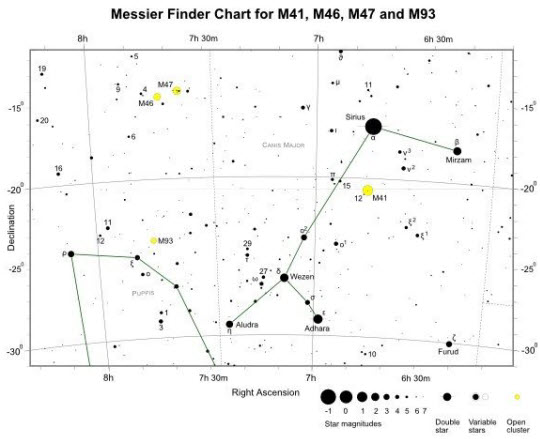
From Cancer, head southwards to find the brightest star in the sky, Sirius, in Canis Major. Place dazzling Sirius at the top of your binocular / finder scope field and move slightly downwards. You should find a lumpy patch of light; this is the open cluster M41 a rather pleasing collection of 3 dozen or so stars visible in small instruments. M41 is another distant cluster lying over 2,100 light-years away.
Next, sight from Mirzam (the bright-ish star to the right of Sirius) through Sirius and continue for twice that distance to an area in the constellation of Puppis ( you can also sight down through Orion’s belt to this same area). Through binoculars / finder scope, a small cloud of light should be visible, this is the open cluster M47, and under dark skies M46, another open cluster is just visible next to M47.
In small scopes M47 resolves easily into a group of stars, M46 still resembles a hazy patch of light, though in 6’’ scopes or larger M46 is the more impressive. Even though these clusters appear next to each other in the sky, in reality M46 is over 3 times further away than M47, 5,000 light-years compared to 1,500 light-years. A third open cluster in Puppis can be found 2-3 binocular fields to the South-East of M46/7, though M93 can be hard to pick out in the “murk” above the South horizon.
Returning to Sirius imagine a line extended to Procyon, the bright star up to the North-East. in Canis Major. A third of the way along this trajectory, in the constellation of Monoceros you will find the faint open cluster M50. a collection of 100 stars 3,000 light-years distant
Our final port of call is in Orion, or should I say it is Orion. For apart from “ruddy” Betelguese which is closer, many of the stars situated in and around the main body of Orion are associated. Most are hot blue stars (Rigel) formed from the same giant molecular cloud several hundred million years ago which are now drifting apart.
I have concentrated on winter open clusters visible in the South aspect of the night sky. There are many other well placed open clusters in the northern half, but these can wait for another time. Good hunting!
Image Credits: NASA
Sky Notes
In this month's Sky Notes:
Planetary Skylights
 Mars lingers in the WSW evening sky for several hours after sunset. On the 19th the red planet passes very close to Neptune when it will be just 18 arc minutes below the gas giant. You will require a telescope to spot Neptune’s tiny disk, nevertheless this will be a great opportunity to glimpse the outermost planet. Optimum time to view is between 5 and 6pm.
Mars lingers in the WSW evening sky for several hours after sunset. On the 19th the red planet passes very close to Neptune when it will be just 18 arc minutes below the gas giant. You will require a telescope to spot Neptune’s tiny disk, nevertheless this will be a great opportunity to glimpse the outermost planet. Optimum time to view is between 5 and 6pm.
.

 Mercury joins Venus in the evening twilight sky and will be visible for most of the month. The pair are closest on the 10th. Look for them 45 minutes after sunset low in the South-West. Dazzling Venus climbs almost straight up from the horizon over the course of the month, and should require no help in identifying, as long as your horizon is relatively uncluttered. Mercury follows Venus up into the sky, reaching it’s highest point by the 18th (approx 9 degrees above the horizon - thereafter it fades, arcing back down to the horizon. Mercury is brightest at the start of its apparition, so try to spot it before the 15th. The crescent moon lies nearby on the evening of the 21st and 22nd.
Mercury joins Venus in the evening twilight sky and will be visible for most of the month. The pair are closest on the 10th. Look for them 45 minutes after sunset low in the South-West. Dazzling Venus climbs almost straight up from the horizon over the course of the month, and should require no help in identifying, as long as your horizon is relatively uncluttered. Mercury follows Venus up into the sky, reaching it’s highest point by the 18th (approx 9 degrees above the horizon - thereafter it fades, arcing back down to the horizon. Mercury is brightest at the start of its apparition, so try to spot it before the 15th. The crescent moon lies nearby on the evening of the 21st and 22nd.
 Conspicuous Jupiter gradually takes centre stage as we head through January and will be well placed for observation throughout the latter part of the evening dominating the eastern aspect of the sky from 8pm onwards. By midnight Jupiter lies almost due south residing just ahead of the ‘sickle asterism’ in Leo, not far from Regulus, its chief star. Viewed through a telescope Jupiter is a wonderful spectacle with its attendant major moons and 'banded' disk, definitely a ‘must see’ object. The moon lies nearby on the 7th.
Conspicuous Jupiter gradually takes centre stage as we head through January and will be well placed for observation throughout the latter part of the evening dominating the eastern aspect of the sky from 8pm onwards. By midnight Jupiter lies almost due south residing just ahead of the ‘sickle asterism’ in Leo, not far from Regulus, its chief star. Viewed through a telescope Jupiter is a wonderful spectacle with its attendant major moons and 'banded' disk, definitely a ‘must see’ object. The moon lies nearby on the 7th.
Looking South: Saturn
close to Crescent Moon on
16-January at 06:45h
(Click image for full-size view)
 Saturn is visible in the early morning sky low to the SE by 6am, although wait until 7am before attempting telescopic observations. A lovely waning crescent moon lies close by on the 16th.
Saturn is visible in the early morning sky low to the SE by 6am, although wait until 7am before attempting telescopic observations. A lovely waning crescent moon lies close by on the 16th.
 Earth reaches Perihelion (closest to the Sun) some 91.4 million miles or 147 million km. on Jan 4th at 07:00h GMT.
Earth reaches Perihelion (closest to the Sun) some 91.4 million miles or 147 million km. on Jan 4th at 07:00h GMT.
Meteor Activity

The New year starts with one of the more prolific meteor showers, the Quadrantids, active between Jan 1st-6th . The shower’s short lived peak normally falls in the early hours of the 4th, around 02:00-04:00h, which along with weather constraints is the main reason it is poorly observed. In favourable observing conditions zenith hourly rates can exceed 100 in the early morning hours, however the moon will be nearly full this time round, drowning out many fainter shooting stars, so expect actual observed rates to be 12-20 per hour.
Quadrantids appear to radiate from the now defunct constellation of Quadrans Muralis, which was removed from sky charts in 1922, but used to lie at the junction between Hercules, Bootes and Ursa Major
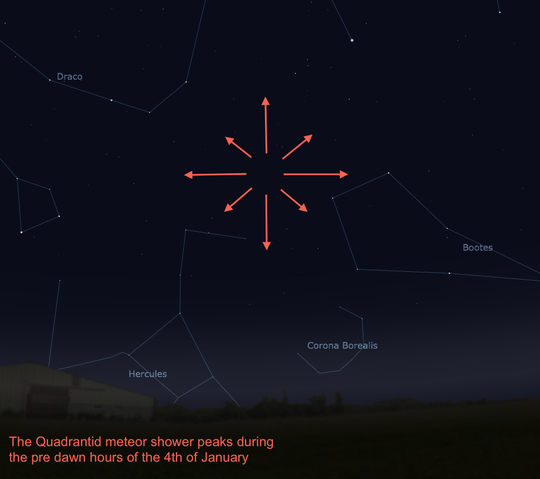
The Winter Solstice
The Sun reached its lowest position in the sky on December 21st this year and we asked for your Solstice photos for the website. As it turned out, sun was particularly scarce that day, but with a day's leeway either way, here are some Solstice photos.
January 2015 Sky Charts
Click each image to see a full-size Sky Chart:
 |
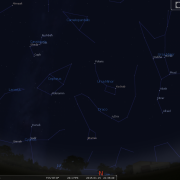 |
| Looking South Mid January - 21:30h |
Looking North |
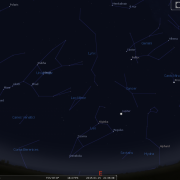 |
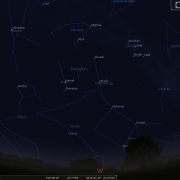 |
| Looking East Mid January - 21:30h |
Looking West Mid January - 21:30h |
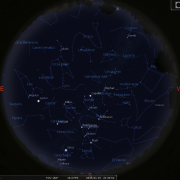 |
|
| Overview Mid-January - 21:30h |
Image Credits:
- Planets and Comets where not otherwise mentioned: NASA
- Sky Charts: Stellarium Software

